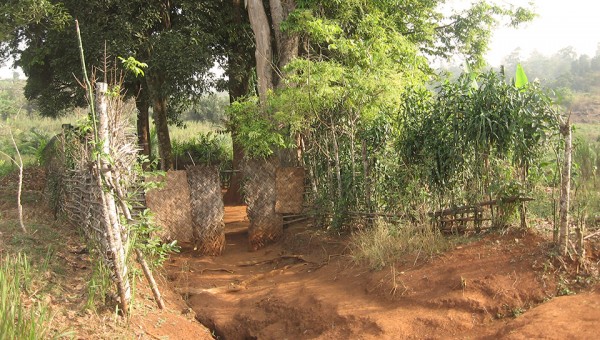
புனித இயற்கை தளங்கள் முனைப்பு வழக்கமாக ப்பாளர்கள் "பாதுகாப்பு அனுபவங்கள்" கொண்டுள்ளது, பாதுகாக்கப்பட்ட பகுதியில் மேலாளர்கள், விஞ்ஞானிகள் மற்றும் மற்றவர்கள். இந்த பதவியை திரு அனுபவங்களும் கொண்டுள்ளது. செபாஸ்டின் லுக் கம்கா-கம்டெம் PhD தற்போது மத்திய ஆப்பிரிக்கப் பாதுகாக்கப்பட்ட பகுதிகள் நெட்வொர்க்கில் பணிபுரிகிறார் (RAPAC). செபாஸ்டின் பேண்ட்ஜவுனில் உள்ள புனிதமான இயற்கை தளங்களில் பணிபுரிந்து வருகிறார், மேற்கு கேமரூன் மற்றும் இந்த சிறப்பு இடங்களுக்கு கலாச்சார மற்றும் உயிரியல் மறுசீரமைப்பு முறைகளின் அவசியத்தை அடையாளம் கண்டுள்ளது. முழு வழக்கு ஆய்வை படிக்க இங்கே கிளிக் செய்யவும் "Bandjoun சேக்ரெட் தளங்கள், மேற்கு கமரூன்“.

Bandjoun நிர்வாக மையத்தில் அமைந்துள்ள, Tchuep-Poumougne hight ஆன்மீக மதிப்பு ஒரு பயமாக பகுதியாகும். கடந்த காலத்தில் அதன் infuence பகுதியில் பீட் குவார்ட்டர் முழு மூடப்பட்டிருக்கும். ஏனெனில் நகரமயமாக்கல் அதன் சுற்றுப்பகுதி சுற்றுச்சூழல் மதிப்புகள் வெகுவாக குறைந்தன மற்றும் வேண்டும் சரணாலயம் எஞ்சியுள்ள மட்டுமே மைய. போட்டோ; செபாஸ்டியன் லுக் Kamga-Kamdem (2008).
கேமரூனின் மேற்குப் பகுதியில் உள்ள பேண்ட்ஜவுன் பிரதேசத்தில் உள்ளூர் மக்களால் புனிதமானதாகக் கருதப்படும் பல்வேறு தளங்கள் உள்ளன.. குடும்ப ஆலயங்கள் மற்றும் சமூகம் கூடும் இடங்கள் போன்ற இப்பகுதியில் உள்ள பழங்குடியினர் மற்றும் சமூகங்களின் அடையாளத்தை பிரதிநிதித்துவப்படுத்தும் வரலாற்று ரீதியாக மிகவும் விரிவான தளங்களின் முக்கிய எச்சங்கள் அவை.. பெரும்பாலான தளங்களின் பகிரப்பட்ட செயல்பாடு தெய்வங்களின் வழிபாடு. இந்த புனிதமான இயற்கை தளங்களின் சூழலியல் இன்றுவரை சிறிய கவனத்தைப் பெற்றிருந்தாலும், அவை சுற்றியுள்ள பகுதிகளிலிருந்து பெரும்பாலும் மறைந்துவிட்ட விலங்குகளையும் தாவரங்களையும் அடைக்கின்றன.
இந்தப் பகுதிகள் சமூக அடையாளத்துடன் வலுவாக இணைக்கப்பட்டுள்ளதாலும், அதனால் நன்கு பராமரிக்கப்படுவதாலும் புனிதப் பகுதிகளின் உயிர்வாழ்வுக்கு அச்சுறுத்தல் இல்லை என்று பாரம்பரியத் தலைவர்கள் தெரிவித்தனர்.. இருப்பினும், புனிதமான இயற்கை தளங்களை நிலைநிறுத்திய கலாச்சார துணியின் வலிமையைப் பற்றி அவர்கள் கவலைப்படுகிறார்கள். பெருகிய முறையில் பொருள்முதல்வாதமாகி வரும் இளைஞர்களின் மனப்பான்மை மாறுவது, அவர்கள் டோபூக்களுக்குக் கீழ்ப்படியாமல் இருப்பதற்கும், மூதாதையரின் நம்பிக்கைகளுக்கு மதிப்பளிக்காததற்கும் காரணமாகிறது.. இன்று, பலர் தங்கள் பாதுகாவலருக்கு தெரிவிக்காமல் புனித பகுதிகளைப் பயன்படுத்துகிறார்கள், கலாச்சார விதிமுறைகளின் அரிப்பைக் குறிக்கிறது. மேலும் முக்கிய அச்சுறுத்தல்கள் அடையாளம் காணப்பட்டுள்ளன, இன்னும் பெரும்பாலானவர்கள் உள்ளூர் மக்களிடையே விவாதத்தில் உள்ளனர்.
பல நூற்றாண்டு கடந்து, பேண்ட்ஜவுன் மக்கள் புனித இயற்கை தளங்களின் மூதாதையர் மேலாண்மை முறையை உருவாக்கியுள்ளனர். இயற்கை மற்றும் அரை இயற்கை புனித தளங்களின் இருப்பிடம் தொடங்கப்பட்ட ஆன்மீக தலைவர்களால் அடையாளம் காணப்படுகிறது (Mkamsi). பெரும்பாலானவை நீண்ட காலமாக நிறுவப்பட்டுள்ளன, ஒரு புனிதப் பகுதியின் இருப்பிடம் மாறாதது மற்றும் சாலை கட்டுமானம் அல்லது சமூக-அரசியல் மறுசீரமைப்பு போன்ற காரணங்களுக்காக மாற்றப்படலாம்.. பொதுவாக, ஒவ்வொரு புனிதப் பகுதியும் நோங்சூப் என்ற பாதுகாவலரின் பொறுப்பின் கீழ் வருகிறது. பிரசாதங்கள் மற்றும் தியாகங்களைச் செய்வதற்கு அவர் பொறுப்பு, அதற்காக அவர் ஒரு பிரதிநிதியை கட்டாயப்படுத்த முடியும். தொடங்கப்பட்ட பெரியவர்கள் உலகளாவிய பாதுகாவலர்கள். எல்லா வழிபாட்டு தளங்களிலும் வேலை செய்ய அவர்களுக்கு உரிமை உண்டு.
புனித பகுதிகளைப் பாதுகாப்பதை ஆதரிக்கும் மிகப்பெரிய முன்னேற்றம் அவர்களின் சட்ட அங்கீகாரமாக இருக்கும், பொது விழிப்புணர்வு அதிகரித்தது, நில பயன்பாட்டில் எதிர்மறையான மாற்றங்களைக் குறைத்தது மற்றும் அவற்றின் சமூக-கலாச்சார மற்றும் சுற்றுச்சூழல் முக்கியத்துவத்தை சிறப்பாக அங்கீகரித்தல். மேற்கூறிய அனைத்தையும் அடைய உள்ளூர் பங்குதாரர்களின் ஈடுபாடு தேவைப்படும், தேசிய மற்றும் சர்வதேச நிலைகள். மேலும் படிக்கவும்.






